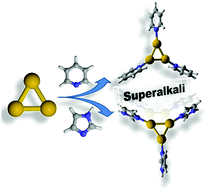On the making of aromatic organometallic superalkali complexes†
Abstract
Superalkalis are complexes that have a lower ionization energy than that of the corresponding alkali and alkaline earth metals. Based on First Principles calculations, the plausible existence of a superalkali complex consisting of an all-metal aromatic trigonal Au3 core coupled with pyridine (Py) and imidazole (IMD) ligands is suggested. The calculated ionization energy (IE) values of the subsequent organometallic complexes, Au3(Py)3 and Au3(IMD)3, are low, thereby mimicking the usual behavior of a superalkali. First order hyperpolarizability calculations show the existence of non-linear optical properties in some of the complexes, which is also on par with the properties of a superalkali.



 Please wait while we load your content...
Please wait while we load your content...